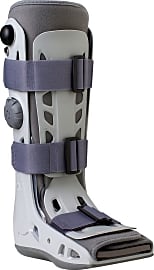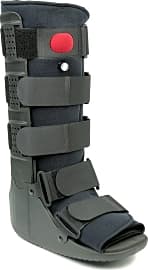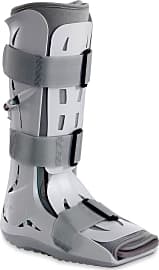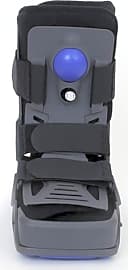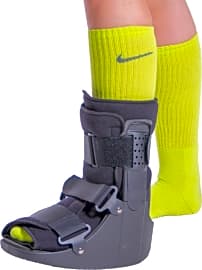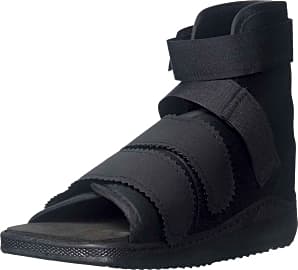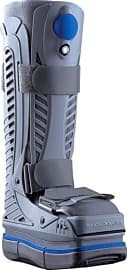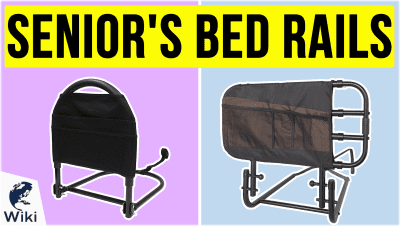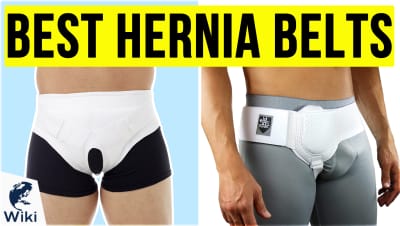The 9 Best Fracture Boots

This wiki has been updated 39 times since it was first published in July of 2015. If you have a bad ankle sprain, foot injury, or broken bone, make sure you safeguard your extremity during recovery with a quality fracture boot. It will protect the damaged area, ensuring that you get back on your feet as quickly as possible. And although we probably don’t need to say it, remember that one of these on its own is no substitute for a trip to the doctor. When users buy our independently chosen editorial selections, we may earn commissions to help fund the Wiki.
Editor's Notes
February 24, 2021:
As much as we might like to hope there are amazing breakthroughs in medical devices every year that make the healing process easier, less painful, and simply quicker, this isn't actually the case in many products. Take for example, these fracture boots. While they are certainly more advanced than what people may have worn 25 years ago, sometimes with the addition of cushioning air pockets and the ability to offer excellent stabilization while still allowing for a somewhat natural gait, they are generally going to be the same as doctor's would have recommended five to 10 years ago, or even longer. As such, we have determined that no adjustments need to be made to our current recommendations, though we will be quick to update this list if that changes.
June 06, 2019:
Since every fracture is different, we've chosen a diverse group of boots that are designed to support a range of injuries. Some of the popular options on the market feature air-pump technology that makes it possible to achieve a custom fit. If you prefer something more old-school, standard foam-and-strap models are also included in this list. There are boots here that are ideal for foot and ankle injuries, as well as mid-calf and knee-high options that are designed for tibia fractures.
The Vacoped Achilles was added and moved to top spot due to its sturdy construction and popularity, and the Complete Medical Slimline is another new addition for similar reasons. The Ovation Medical Braces Pneumatic was removed due to quality concerns and availability issues.
Benefits Of Fracture Boots
Plaster and fiberglass casts are also not able to come into contact with water.
Doctors initially used fracture boots as adjunct therapies to ease patients into full functionality. Now they are a primary treatment for many injuries in the foot and ankle. There are many benefits of using fracture boots over rigid plaster or fiberglass casts. For example, fracture boots are much more comfortable than plaster casts. Plaster casts are applied directly to the skin and are not very breathable. Patients complain they are uncomfortable, especially when sweat collects in between the cast and the skin. This can cause tremendous itching, and may put a patient at risk for bacterial growth leading to skin conditions such as heat rash and atopic dermatitis.
Plaster and fiberglass casts are also not able to come into contact with water. This makes things like bathing very difficult. Fracture boots are much more manageable. Patients can carefully remove the boot after a certain period of time to gently wash and dry the leg. This also reduces the other complications, such as sweat seeping back into the pores. When plaster casts are removed, they often reveal an ankle that has experienced significant changes. The skin may be discolored, dry, and flaky. Hair on the leg and foot may get darker, and patients may notice muscle loss caused by inactivity. Fracture boots address many of these problems. Carefully removing the boot to help stretch and strengthen the joint during recovery can help prevent these issues, and this is conveniently possible in a fracture boot.
Ankle fractures may be especially dangerous to athletes, as the complications that can arise from a poorly treated fracture can be career-ending in some cases. The full recovery time for an athlete will vary greatly, from three up to 51 weeks. Modern fracture boots may greatly improve the healing process for athletes, as they allow for the patient to strengthen the ankle during recovery using guided exercises.
Deciding Which Fracture Boot Is Best For You
Immobilization therapy has been around for thousands of years. Many different ancient civilizations had their own unique versions of orthopedic braces. Homemade versions of ancient immobilization techniques are still used in some areas of the world. These splints may be helpful in very minor strains, but will not be enough for serious sprains or fractures. It is best to turn to a trusted fracture boot in these cases.
Doctors typically recommend tall boots for injuries that need more stabilization and support, such as ankle fractures.
You can use fracture boots to treat a number of issues, such as ankle sprains and fractures, plantar fasciitis, foot fractures, metatarsal stress fractures, and even tendonitis. Understanding the type of injury the patient has and which boot will be most beneficial must be considered before recommending the use of a fracture boot. Doctors generally recommend short boots in cases where the injury is lower on the foot, such as a metatarsal fracture or plantar fasciitis. These injuries require less support and will benefit most from the level of immobilization a short boot provides. Doctors typically recommend tall boots for injuries that need more stabilization and support, such as ankle fractures.
The shape of the patient’s foot and leg may also play a role in which fracture boot they should buy. People with larger calves or those who suffer from inflammatory disorders like edema may need special casts that can accommodate larger legs. Temporary inflammation caused by a sprain or fracture may prevent some boots from properly immobilizing the leg, too. Pneumatic boots can pump air into any space in between the foot and the cast. This helps create a more complete immobilization in cases where inflammation from the injury would keep a normal fracture boot from working as intended. This can make all the difference in treatment, as immobilization is the most important function of a fracture boot.
How Important Is A Fracture Boot?
We intuitively understand the importance of immobilizing an injury like a fractured ankle. Stepping on a recently injured leg causes tremendous pain, and putting it in a cast is necessary to even think of continuing on with daily life. Yet most people don't understand that the real treatment begins when the cast comes off. It is easy for a fractured ankle to heal improperly. Typical casts do not allow for movement at all, so all the physical therapy is left until after the cast comes off. Unfortunately, this is also when the ankle is weakest and most at risk. This standard treatment causes long recovery times, muscle atrophy, and may even increase the risk of re-injury.
Fracture boots are now becoming more popular for the treatment of ankle fractures, though.
Recent research has suggested that fracture boots may be more important than commonly understood. While doctors generally use ankle braces for minor sprains, the standard treatment for any serious ankle fracture involves immobilizing the leg by using a plaster cast. Fracture boots are now becoming more popular for the treatment of ankle fractures, though. This is thanks in large part to advances in new materials and technologies, as well as a growing understanding of the healing process. A recent study posted to the Asia-Pacific Journal of Sports Medicine, Arthroscopy, Rehabilitation and Technology investigated the healing times of fracture boots when compared to standard treatment methods.
Researchers selected 47 patients who had undergone surgery for serious ankle fractures. They then separated the patients into two groups. In one group, patients used plaster casts to aid their recovery from the fracture. In the other group, they used used fracture boots. The researchers then measured recovery times in each group by determining how long it took the patients to stand on their injured leg and walk without crutches.
The study concluded that the healing times were significantly shorter in patients using fracture boots. They also tolerated weight-bearing activity during treatment much better, as well. This is because participants who wore fracture boots were able to exercise and keep their range of motion higher during treatment, which is also known to speed healing time. This is nearly impossible with plaster casts. This suggests that fracture boots are important for every stage of the healing process, and may in fact be the best recovery method available.


